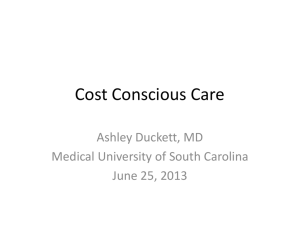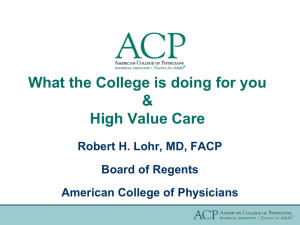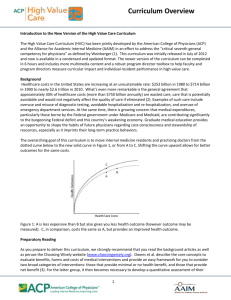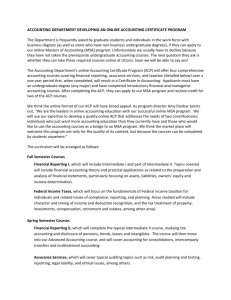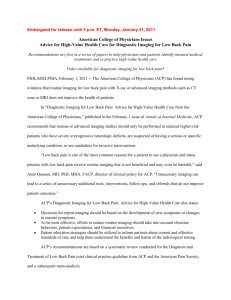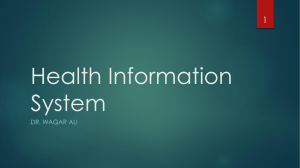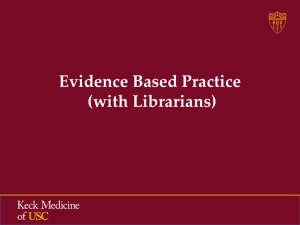Choosing Wisely when Ordering Tests
advertisement
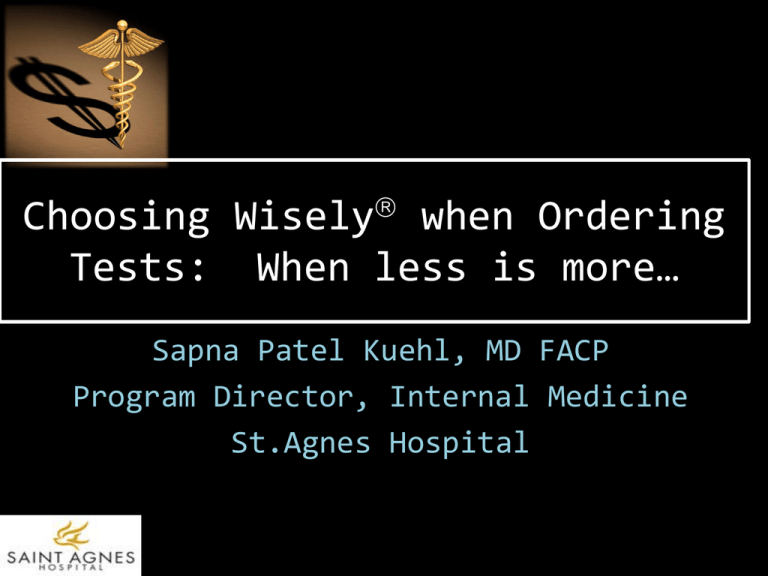
Choosing Wisely when Ordering Tests: When less is more… Sapna Patel Kuehl, MD FACP Program Director, Internal Medicine St.Agnes Hospital Conflicts of Interest None Special thank you to: Dr. Cynthia “Daisy” Smith Senior Medical Associate for Content Development Medical Education Division American College of Physicians DSmith@mail.acponline.org Learning Objectives • Recognize the urgent need for eliminating waste in US Health Care. • Understand Choosing Wisely® Campaign of the ABIM Foundation and it’s goals. • Understand the concept of High Value Cost Conscious Care. • Motivate to eliminate medical tests that provide no benefit and may be harmful. Clinical Case • 35 year-old woman presents to clinic complaining of headaches every 1-2 weeks for the past few months • Headaches preceded by “seeing spots” and associated with nausea • R-sided, pulsatile, lasts approximately 4-8 hours • Cannot identify any “triggers” No Red Flags Onset of headache after age 50 years Change/progression of headache pattern Acute onset of “worst” severe headache Headache in a patient with cancer, immunosuppression or HIV infection Headache with fever (or in context of systemic illness) Headache with an abnormal neurologic examination Migraine and epilepsy Associated with personality change Symptoms of increased intracranial pressure (early AM headache, worse with valsalva, exertion, or sex) Neurological symptoms lasting more than 1 hr Migraine Headaches Likelihood Ratio for migraine by number of POUNDING criteria met1: “POUND” • Pulsating • Duration of 4-72 • 4 of 5 criteria – LR 24 hours • 3 of 5 criteria – LR 3.5 • Unilateral • 2 or fewer criteria – LR • Nausea 0.41 • Disabling Should she get head imaging? Is it needed? How much does it cost? U.S. HEALTHCARE COSTS ARE UNSUSTAINABLE ! •$2,6000,000,000,000 ($2.6 trillion) •10x cost in 1980 •Employer-sponsored health coverage for family premiums 97% in last 10 years! •17.9% of the nation’s Gross Domestic Product (GDP) in 2010. Centers for Medicare and Medicaid Services, Office of the Actuary, National Health Statistics Group, National Health Care Expenditures Data, January 2012 Martin, A.B. et al. January 2012. Growth in US health spending remained slow in 2010; Health share of gross domestic product was unchanged from 2009. Health Affairs 31(1): 208-219 $8233 $5250 Why care about the costs? Medical Professionalism in the New Millennium • Improving access to high-quality health care, • Advocating for a just and costeffective distribution of finite resources, and • Maintaining trust by managing conflicts of interest. http://www.abimfoundation.org/Professionalism/~/media /Files/Physician%20Charter.ashx Why care about the costs? • Decisions are being made related to costs • Affordable Care Act • Lower payments, fewer services covered • 30% ($750-765 billion) per year have been identified as potentially avoidable Excess Cost Estimates Cost in Billions of $$$ $75 $210 $55 $105 $130 $190 Institute of Medicine. 2010. Unnecessary Services ($210 B) Inefficiently Delivered Services ($130 B) Excess Administrative Costs ($190 B) Excessive Pricing ($105 B) Missed Prevention Opportunities ($55 B) Fraud ($75 B) The Healthcare Imperative, 750 Billion! • Buy out of all ad spots from SuperBowl 3061 times over • Over 74 days of ads http://www.pbs.org/newshour/multimedia/health-750b/ Growth in Volume of Physician Services Per Medicare beneficiary 2000-2009 From Reinhardt blog, NY Times, 12/24/2010 Physician Controlled Costs • Unnecessary testing and treatment=210B • Inefficiently delivered care=130B • Missed prevention opportunities=55B 395 Billion Are We Willing (and Able) to Address the Problem? Physicians Agree That Healthcare is Overused Survey of primary care physicians • 42% believe patients in their own practice are receiving too much care (vs. 6% who say “too little”) • Perceived factors leading to overuse – Malpractice concerns: 76% – Clinical performance measures: 52% – Inadequate time to spend with patients: 40% Arch Intern Med. 2011; 171:1582-1585 ACP High Value Needs Assessment Survey Unpublished Data: 427 respondents; courtesy of Dr. Cynthia Daisy Smith Challenges to High Value Needs Assessment A practicing physician knowledge gap: – costs of services in healthcare 93% – balancing benefits with harms and costs 85% Unpublished Data: courtesy of Dr. Cynthia Daisy Smith Reasons for overuse • Diagnostic uncertainty 74% • Malpractice fear 65% • Inadequate patient follow-up or access 59% • Time savings 50% • Patient request 47% Data: ACP High Value Needs Assessment Survey courtesy of Dr. Cynthia Daisy Smith Drivers of the shortfalls "2 Unnecessary Services." The Healthcare Imperative: Lowering Costs and Improving Outcomes • Scientific uncertainty • Perverse economic and practice incentives • System fragmentation • Opacity as to cost, quality, outcomes • Changes in the population’s health status • Lack of patient engagement in decisions • Underinvestment in population health Young, Pierre L., Olsen, LeighAnne, Roundtable on Evidence-Based Medicine, Institute of Medicine. "2 Unnecessary Services." The Healthcare Imperative: Lowering Costs and Improving Outcomes: Workshop Series Summary. Washington, DC: The National Academies Press, 2010. Recommendations for change-slide 1/2 • Streamlined and harmonized health insurance regulation • Administrative simplification and consistency • Payment redesign to focus incentives on results and value • Quality and consistency in treatment, with a focus on the medically complex • Evidence that is timely, independent, and understandable Young, Pierre L., Olsen, LeighAnne, Roundtable on Evidence-Based Medicine, Institute of Medicine. "2 Unnecessary Services." The Healthcare Imperative: Lowering Costs and Improving Outcomes: Workshop Series Summary. Washington, DC: The National Academies Press, 2010. Recommendations for change-2/2 • Transparency requirements as to cost, quality, and outcomes • Clinical records that are reliable, sharable, and secure • Data that are protected but accessible for continuous learning • Culture and activities framed by patient perspective • Medical liability reform • Prevention at the personal and population levels Young, Pierre L., Olsen, LeighAnne, Roundtable on Evidence-Based Medicine, Institute of Medicine. "2 Unnecessary Services." The Healthcare Imperative: Lowering Costs and Improving Outcomes: Workshop Series Summary. Washington, DC: The National Academies Press, 2010. Back to Case • 35 year-old woman with headaches • “POUND” criteria • 4 of 5 criteria – LR 24 • Cost of head imaging?? – CT Head – MRI Brain Cost of Head Imaging CT Head US Minimum Price $ 750 US Average Price $ 1,150 US Maximum Price $ 4,200 MRI Brain U.S. Minimum Price $ 1,650 U.S. Average Price $ 2,550 U.S. Maximum Price $ 7,300 http://healthcarebluebook.com/ and http://clearhealthcosts.com/ National Initiatives • Archives of Internal Medicine: “Less is More” series 2010 • National Physicians Alliance: “Promoting Good Stewardship in Medicine :Top 5” Campaign Less Is More: How Less Health Care Can Result in Better Health Deborah Grady, MD, MPH; Rita F. Redberg, MD, MSc May 10, 2010 National Initiatives • ABIM Foundation 2011: Choosing Wisely Campaign • High Value, Cost-Conscious Health Care Initiative ACP 2011 • Avoiding Avoidable Care Conference April 2012 www.avoidablecare.org Less Is More: How Less Health Care Can Result in Better Health Deborah Grady, MD, MPH; Rita F. Redberg, MD, MSc May 10, 2010 Choosing Wisely Campaign • Promote conversations between physicians and patients • Help patients choose care that is: – Supported by evidence – Not duplicative of other tests or procedures already received – Free from harm – Truly necessary Choosing Wisely Campaign • American Academy of Allergy, Asthma & Immunology • American Academy of Family Physicians • American College of Cardiology • American College of Physicians • American College of Radiology • American Gastroenterological Association • American Society of Clinical Oncology • American Society of Nephrology • American Society of Nuclear Cardiology • National Physicians Alliance Choosing Wisely New Partners- Feb 2013 • • • • • • • American Academy of Hospice and Palliative Medicine American Academy of Neurology American Academy of Ophthalmology American Academy of Otolaryngology–Head and Neck Surgery American Academy of Pediatrics American College of Obstetricians and Gynecologists American College of Rheumatology • • • • • • • • • American Geriatrics Society American Society for Clinical Pathology American Society of Echocardiography American Urological Association Society of Cardiovascular Computed Tomography Society of Hospital Medicine Society of Nuclear Medicine and Molecular Imaging Society of Thoracic Surgeons Society for Vascular Medicine • AARP • Choosing Wisely Consumer Organization Partners Alliance Health Networks • Leapfrog Group • • • • • • • • Midwest Business Group on Health Minnesota Health Action Group National Business Coalition on Health National Business Group on Health National Center for Farmworker Health National Hospice and Palliative Care Organization National Partnership for Women and Families Pacific Business Group on Health • Service Employees International • Union Plus • Wikipedia Community residence) Union (SEIU) (through a dedicated Wikipedian in Patient Materials When you need them and when you don’t •Allergy tests: When you need them and when you don’t •Bone Density Tests •Chest Xrays before surgery •EKGs and exercise stress tests •Chronic Kidney Disease: Making Hard Choices •Hard decisions about cancer: 5 tests and treatments to question •When do you need antibiotics for sinusitis? •How should you treat heartburn and GERD? •When do you need an imaging test for a headache? 1. Don’t obtain screening exercise electrocardiogram testing in individuals who are asymptomatic and at low risk for coronary heart disease. 2. Don’t obtain imaging studies in patients with non-specific low back pain. 3. In the evaluation of simple syncope and a normal neurological examination, don’t obtain brain imaging studies (CT or MRI). 4. In patients with low pretest probability of venous thromboembolism (VTE), obtain a high-sensitive D-dimer measurement as the initial diagnostic test; don’t obtain imaging studies as the initial diagnostic test. 5. Don’t obtain preoperative chest radiography in the absence of a clinical suspicion for intrathoracic pathology. Current Philosophy at ACP • Focus now on the “low-hanging fruit”: interventions with low or no benefit, independent of cost • Goal: reduce inappropriate care that does not help (or even harms) patients • Ultimate outcomes: reduced cost better patient care, ACP Slides: courtesy of Dr. Cynthia Daisy Smith, ACP ACP’s High-Value, CostConscious Care Initiative • Eliminate health care spending on interventions that do not improve health outcomes • ACP is not proposing that care be rationed • Rational care: assuring that care is clinically effective, thus avoiding overuse or misuse of care that is inappropriate • Rationing: decisions are made about the allocation of scarce medical resources and who receives them, leading to underuse of potentially appropriate care Owens DK et al for Clinical Guidelines Committee of ACP. High Value Cost-conscious Health Care: Concepts for Clinicians to Evaluate the Benefits, Harms, and Costs of Medical Interventions. Ann Intern Med. 2011; 154: 174-180 Shifting focus: More ≠ Better Health Outcomes C A A B A to B = higher cost for better outcome A to C = more value Health Care Costs Owens DK et al for Clinical Guidelines Committee of ACP. High Value Cost-conscious Health Care: Concepts for Clinicians to Evaluate the Benefits, Harms, and Costs of Medical Interventions. Ann Intern Med. 2011; 154: 174-180 Value, Cost and Healthcare Cost ≠ Value Cost ≠ Cost of Test • Cost = cost of test + downstream costs, benefits and harms • Low-cost interventions may have little or no value if they provide little benefit or SIGNIFICANTLY increase downstream costs. Owens DK et al for Clinical Guidelines Committee of ACP. High Value Cost-conscious Health Care: Concepts for Clinicians to Evaluate the Benefits, Harms, and Costs of Medical Interventions. Ann Intern Med. 2011; 154: 174-180 Benefit, Cost, and Value High Benefit High Cost Anti-retroviral therapy for HIV Value: high Low Cost HIV screening Value: highest Low Benefit Routine MRI for low back pain Value: lowest Annual pap smears Value: low Value Measurement: Quality Adjusted Life Years (QALYs) • An important metric for measuring health benefits by taking into account both length and quality of life • Allows for comparison of interventions between different specialities (compare cancer treatments with cardiovascular treatments) Cost-Effectiveness Threshold: How Much is Health Worth? • Threshold depends on who is making the decision and their willingness to pay for better health outcomes • National Health Service in UK $30,000$50,000/ QALY • No consensus in US - citizens have been willing to pay up to $109,000/QALY, most US decision makers consider interventions that cost less than $50,000-$60,000/QALY high value Prevention Measures Cost-Effectiveness Ratio QALY Examples One time colonoscopy screening for ca Cost-Saving High intensity smoking prevention $190/QALY Screening 60 y o for Diabetes $25,738/QALY Treatments for existing conditions ART for HIV $29,000/QALY Implantation of defibrillators $52,000/QALY Surgery in 70 y o male with prostate ca Increased cost and worsens health M 2008:358:661-663 Steps Toward High-Value, CostConscious Care 1 • Understand the benefits, harms, and relative costs of the interventions that you are considering • Decrease or eliminate the use of interventions that provide no benefits and/or may be harmful • Choose interventions and care settings that maximize benefits, minimize harms, and reduce costs (using comparativeeffectiveness and cost-effectiveness data) 1Owens, D. Ann Intern Med. 2011;154:174-180 Steps Toward High-Value, CostConscious Care 1 • Customize a care plan with the patient that incorporates their values and addresses their concerns • Identify system level opportunities to improve outcomes, minimize harms, and reduce healthcare waste 1Owens, D. Ann Intern Med. 2011;154:174-180 Education of Target Audiences 1. Practicing physicians 2. Trainees (students, residents, and fellows) 3. Patients Targeting Practicing Physicians • High value care recommendations in MKSAP 16, Annual live ACP meeting • ACP Waxman Clinical Skills Center: provide more cost effective and comprehensive care • New Maintenance of Certification (MOC) activities: eliminating misuse and overuse • Smartmedicine (free for ACP members) • Guidelines, guidance statements, position papers Education of Trainees - AAIM-ACP Curriculum is available for free download at www.highvaluecarecurriculum.org – SIMPLE and other interactive cases Educating Patients • High quality patient information materials to accompany physician education materials • ABIM Collaboration with Consumer Reports • Patient fair at annual ACP meeting in April in San Francisco • ACP collaboration with AHRQ’s Effective Healthcare Program Future Challenges in Eliminating Waste • End of life care • Appropriate use of subspecialty consultation and referral • Decreasing hospitalization and ER utilization • Over-pricing • Price transparency • Defensive medicine • Improved reimbursement for care coordination • Alignment of financial incentives • Physician financial conflict of interest Paradigm Shift •National Health Care Debate •“Doc fix” •Medical Malpractice Reform •Active role of Physicians •Reconstruct health care industry •Patient Expectations Are we merely postponing the reckoning? Medical costs typically increase by a few to several percent per year (after adjustment for inflation). • “Costs will resume their rise unless we start saying no to some beneficial care.” • “Eliminating only ineffective care would shift the cost curve down but wouldn't change its slope.” Beyond the “R Word”? Medicine's New Frugality M. Gregg Bloche, M.D., J.D. NEJM 2012; 366:1951-1953May 24, 2012DOI: 10.1056/NEJMp1203521 Reasons Residents OverOrder Tests9 1. Duplicating role modeled behavior 2. Desire to be complete 3. Pre-emptive ordering/rushing an evaluation/unnecessary duplication of tests 4. Discomfort with Diagnostic Uncertainty 5. Curiosity 6. Lack of knowledge of the costs and harms 7. Defensive medicine 8. Patient requests 9. Faculty demand 10.No training in weighing benefit relative to cost and harm 11.Ease of access to services when patient is hospitalized Strategy Questions to Ask Before Ordering a Test 8 • Did the patient have this test previously? • Will the result of this test change the care of the patient? • What are the probability and potential adverse consequences of a false positive result? • Is the patient in potential danger in the short term if I do not perform this test? • Am I ordering the test primarily because the patient wants it or to reassure the patient? Conclusions • 365 billion of dollars annually are considered “healthcare waste” • The highest percent of waste occurs in Unnecessary Services category. • Review Choosing Wisely Campaign Recommendations. • Comprehensive Societal Discussion • Medical Malpractice Reform What can we do? • Eliminate unnecessary tests and treatments and teach our students and residents to do the same • Tolerate some diagnostic uncertainty- close follow up and care coordination can help assuage anxiety • Manage patient expectations by talking to them about their values and concerns References 1) 2) 3) 4) 5) 6) 7) 8) 9) 10) Detsky ME, et al. Does this patient with headache have a migraine or need neuroimaging. JAMA 2006;296:1274-1283. ABIM Foundation, Choosing Wisely Campaign. www.choosingwisely.org (accessed 5/1/12). Kaniecki R. Headache assessment and management. JAMA.2003;289:1430-1433. Sager A, Socolar D. Health Costs Absorb One-Quarter of Economic Growth, 2000-2005. Boston: Health Reform Program, Boston University School of Public Health; 2005. Cooke M. Cost consciousness in patient care--what is medical education’s responsibility? NEJM. 2010;362:1253-1255. Thomas Reuters. Where can $700 billion in waste be cut annually from the U.S Health Care system? October, 2009. Uwe E. Reinhardt blog, NY Times, 12/24/2010. Laine C. High-value testing begins with a few simple questions. Ann Intern Med. 2012;156:162-163. Adapted from Neel Shah. Commonhealth. Accessed 10/2011. Qaseem, A. Appropriate Use of Screening and Diagnostic Tests to Foster High-Value, Cost-Conscious Care. Ann Intern Med. 2012;156:147-149 Any Questions or comments? Notable Books • • • • • • Overdiagnosed: Making People Sick in the Pursuit of Health Author: H. Gilbert Welch, MD My Mother, Your Mother: Embracing “Slow Medicine,” the Compassionate Approach to Caring for Your Aging Loved Ones Author: Dennis McCullough, MD How We Do Harm: A Doctor Breaks Ranks About Being Sick in America Author: Otis Webb Brawley, MD Hope or Hype: The Obsession with Medical Advances and the High Cost of False Promises Authors: Richard A. Deyo, MD, MPH and Donald L. Patrick, PhD, MSPH Money-Driven Medicine Author: Maggie Mahar Overtreated Author: Shannon Brownlee, MsC Case #2 • 62 y/o man with ischemic cardiomyopathy presents to the emergency department with increasing dyspnea and orthopnea • Last echo 2 months ago showed LVEF 35% • Returned from cruise yesterday where he was non-compliant with dietary restrictions and missed several doses of his medications • Denies chest pain • Vitals are normal, exam shows volume overload • Further Evaluation? Approximate Costs 1 night in the hospital $1,400 Physician fees (per day): $200 Consulting physician fee (per day): $300 EKG: $60 CXR: $100 Transthoracic echocardiogram: $1,000 CT angiogram of the chest: $1,200 Coronary angiography: $8,000 ECG stress test: $500 Echo/nuclear stress test: $2,000 Electrolyte panel: $50 CBC: $50 Troponin: $75 BNP: $75 Oral medications: $5 per pill IV medications: $80 ($50 for med and $30 for administration) http://www.imaginghealthcare.com/procedures/ Expansion of the High Value Care Initiative • Beyond internal medicine • current work underway with ACOG and CREOG; family medicine, pediatrics and psychiatry also interested; • Collaboration with ACGME Resident/Fellow Council to expand beyond IM
